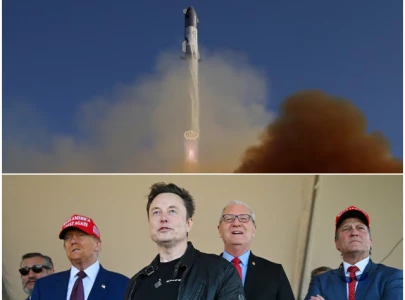

SpaceX launched its massive Starship rocket from Texas on Tuesday, advancing its spaceflight capabilities but failing to recover its booster as planned. The launch was witnessed by US President-elect Donald Trump at the company's rocket facility in Boca Chica.
The 400-foot (122-metre) rocket system, designed for lunar and Martian missions, lifted off at 4 p.m. CT (2200 GMT). Its first stage booster, Super Heavy, separated at an altitude of around 40 miles (62 km) and sent the upper-stage Starship into space.
However, Super Heavy unexpectedly splashed down in the Gulf of Mexico rather than returning to the launch tower's mechanical arms as intended, suggesting an issue during the landing sequence. A separate livestream captured the booster exploding in a massive fireball after hitting the water.
Starship, however, achieved several milestones, including a successful reignition of its space-adapted engine for the first time. This critical test of in-space manoeuvrability marked progress for the spacecraft, which later splashed down in the Indian Ocean approximately an hour after launch.
NASA Administrator Bill Nelson congratulated SpaceX, highlighting the successful engine reignition as a significant step toward achieving orbital flight.
The mission also signals stronger ties between SpaceX CEO Elon Musk and President-elect Trump, who has shown enthusiasm for Musk’s innovations, particularly Starship's novel catch-landing technology. Trump’s presence at the launch underscores a burgeoning partnership, with Musk likely to benefit from the new administration's policies.
Musk was a vocal supporter of Trump’s campaign, providing substantial financial backing. Following Trump’s election, he appointed Musk as co-leader of a government efficiency initiative aimed at reducing waste and regulatory burdens.
Musk has frequently criticised the US Federal Aviation Administration (FAA) for slowing SpaceX’s progress, but Tuesday's launch approval marked the FAA’s quickest regulatory turnaround for SpaceX to date.
The test flight aimed to achieve four key objectives: demonstrating engine reignition in space, performing a daytime ocean landing, subjecting Starship to higher reentry temperatures, and accelerating booster recovery. Musk noted that thousands of design tweaks were also being evaluated.
SpaceX has ambitious goals for Starship, with the company seeking rapid development under the incoming administration, which is expected to prioritise NASA’s Artemis programme and broader aspirations for Martian exploration.
SpaceX President Gwynne Shotwell recently suggested the company could achieve as many as 400 Starship launches over the next four years, matching the milestone reached by its Falcon rocket fleet.